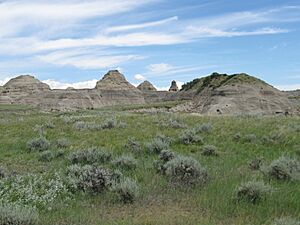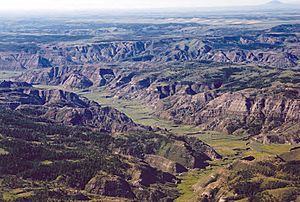Eastern Montana facts for kids
Eastern Montana is a large region in the eastern part of the state of Montana. People often think of it as the eastern third of the state. This area is known for its wide-open spaces and unique landscapes.
Parts of Eastern Montana are seeing a lot of economic growth. This is because of the Bakken formation, which is the biggest oil discovery in U.S. history.
Contents
History of Eastern Montana
The plains of Eastern Montana were once home to many Plains Indian tribes. These included groups like the Sioux, Blackfeet, and Crow. They lived off the land and had rich cultures.
By the late 1800s, people from Europe began to settle here. They built homesteads, which were farms or ranches. The Native Americans were mostly moved to Indian reservations. Even today, Eastern Montana has a strong and proud Native American population.
Eastern Montana was also the site of a very famous battle. This was the Battle of the Little Bighorn.
Building Fort Peck Dam
The Fort Peck Dam is a huge project located near Glasgow, Montana. It was built as part of the New Deal. The New Deal was a series of programs created by the U.S. government. These programs helped the country recover from the Great Depression. The dam was a project of the Public Works Administration. This group created jobs for many people.
Construction on Fort Peck Dam started in 1933. At its busiest time in 1936, over 10,000 workers were building it. The dam was finished in 1940. It started making electricity in 1943. The dam was named after a trading post from the 1800s.
Geography and Climate of Eastern Montana
Eastern Montana has a semi-arid steppe climate. This means it's quite dry, but not a true desert. It gets low amounts of rain, usually about 10 to 20 inches (250 to 510 mm) each year. Most of this rain comes from summer thunderstorms. Snow can fall at any time of the year.
Summers in Eastern Montana are short but can be very hot. Winters are long, cold, and can change a lot. Sometimes, warm winds called chinook winds blow down from the Rocky Mountains. These winds can make winter temperatures much milder, sometimes reaching 35 to 60 °F (2 to 16 °C) for weeks. Other winters can be very cold. Temperatures might stay below 0 °F (−18 °C) for weeks at a time.
Eastern Montana's Unique Landscapes
The flat, grassy areas of Eastern Montana are often seen as part of the Great Plains. However, recent studies show that its plant and animal life are also similar to other regions. These include the scrub steppes of the Intermountain West and the Palouse area of Eastern Washington.
Some parts of Eastern Montana can get very dry, especially with the chinook winds. These areas can have almost desert-like conditions. They might have scrub plants instead of just grassland. Eastern Montana also has hills and highlands that are covered in forested areas. Examples include the Custer National Forest and areas around Fort Peck Lake. This is different from the mostly treeless plains found further east in the Midwest.
Culture in Eastern Montana
Many of the early settlers in Eastern Montana came from Germany and Scandinavia. This included many people from Norway. Their cultures helped shape the region.
Cities and Towns in Eastern Montana



